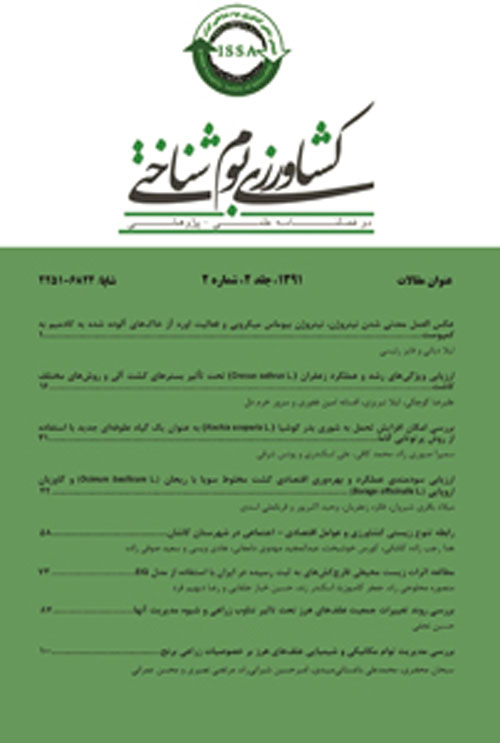Study and comparison of temperature changes impacts on grain yield of irrigated maize (Zea mays L.) in Khuzestan and Fars provinces
Author(s):
Abstract:
Introduction
In recent decades, plant yield is said to have been affected by three major factors: genetics, management and climate change (Ciampitti and Vyn, 2012). However, climate change has been reported as the most effective factor on the yield of wheat, rice and maize crops (Li et al., 2010). Both modeling and empirical studies have indicated that maize yield is negatively affected by climate change at the global scale (Lobell et al., 2011). Among climatic factors, temperature plays a significant role on crop growth (Wallach et al., 2006) and each species has a specific temperature range represented by a minimum, maximum, and optimum (Hatfield and Prueger, 2015). This study was performed to investigate the effect of these factors on grain yield of irrigated maize in two provinces of Iran, Khuzestan and Fars, which include the largest area of maize cultivation.Materials And Methods
The present experiment was conducted in 2014 and by study of eight locations in Khuzestan and Fars Provinces. The long-term data of irrigated maize yield in the studied cities were collected from the Ministry of Agriculture and the long-term weather data including minimum temperature, maximum temperature and average temperature were collected from the Iranian Meteorological Organization. Total weather data were controlled by the Tamet program and outliers were deleted. Then, the appropriate period for investigating weather data was selected based on maize growth period in each city. Also, in order to eliminate the effects of genetic improvement and management, the double exponential smoothing method was employed. To calculate weather parameter changes, trend and the relationship between maize yield and weather parameters were used as a simple linear regression. Finally, drawing graphs and Fig.ures was performed using Microsoft Excel 2003 and SigmaPlot v.11.Results And Discussion
The results of present study showed that the minimum, maximum and average temperatures increased in most of the cities studied. Also, it can be stated that a rise in the average temperature has been more greatly affected by the minimum temperature than the maximum temperature. Generally, in all cities of Fars province the temperature throughout the maize growing season was in the optimal range for maize and higher yields in these cities could be due to a more favorable temperature. The results showed that the lowest median average temperature during growth period belonged to Fasa (22.87 ° C) and Shiraz (25.42 ° C). Similarly, the highest median yield was also belonged to Fasa and Shiraz with 8539.11 and 7934.42 kg ha-1, respectively. In contrast, Shushtar and Ahvaz showed the highest median average temperature and had the lowest yield among the studied cities. In general, it seems that higher grain yield in the locations studied in Fars province could be because of a lower temperature in the maize growing season compared with Khuzestan province. Results of the double exponential smoothing method and regression analysis indicated that the regression coefficients between smoothed maize yield and maximum, minimum and average temperature were not significant in any cities except in Marvdasht where there was a negative relationship between rising temperature and maize yield. Conclusion
Despite the non-significant statistical relationship between maize yield and weather parameters in the studied locations, it is important to consider national food security which will probably be affected by rising temperatures in the future. This negative effect may be overcome by developing and using suitable new methods for adaptation and mitigation in face of climate change. Keywords:
Language:
Persian
Published:
Journal of Agroecology, Volume:6 Issue: 1, 2016
Page:
118
https://magiran.com/p1586440
سامانه نویسندگان
مقالات دیگری از این نویسنده (گان)
-
The status of achieving the Sustainable Development Goals in 2023
Zeynab Hossein Nejad *,
Iran Nature, -
Assessing farmers’ adaptation to climate change risks (case study: Hashtroud County)
Mohammad Kheiri*, , Niloofar Izadi
The Quarterly Journal of Insurance and Agriculture, -
Wind erosion and economic estimation of its impacts at the origin (Case study: Hamon wetland)
Saleheh Erfani, Jafar Kamouzia, F .Aghamir, Hossein Sargazi, MohammadReza Nazari, HASSAN ESMAEILZADEH*
Journal of Spatial Planning,



